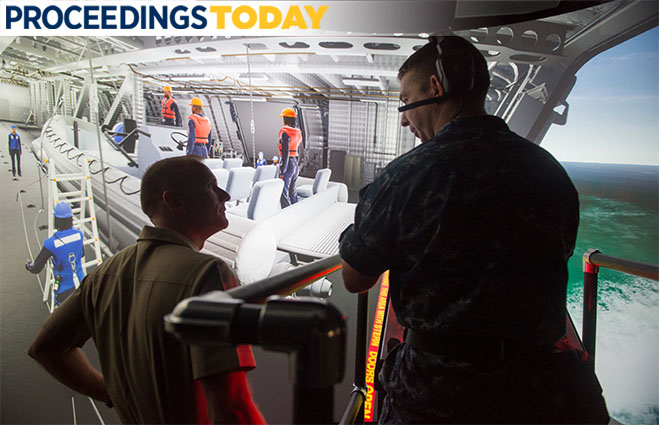
During the 7 September 2017 House Armed Services Committee (HASC) hearings on Navy readiness in the wake of recent incidents, Admiral Bill Moran, Vice Chief of Naval Operations, was asked about Navy investment in and use of next-generation training to improve training efficiency and effectiveness. These good questions have bearing well beyond the ability of surface combatants to routinely steam in the world’s shipping lanes. Increasing the speed, effectiveness, and sustainment of Navy training is of growing importance to all the services’ missions, from peacetime transits to high-end naval warfare.
The Navy has invested heavily in trainers for a long time, but these are flight simulators, submarine control room simulators, shiphandling trainers, and complex schoolhouse integrated trainers that are not scalable, mobile, or affordable. State-of-the-art in its day, such technology has limitations. It is very expensive, takes years to develop and deploy, requires large support infrastructure and staffs, is difficult to update as the platforms change, and is not readily available. When you have nothing, such trainers are a real boon, but technology has now bypassed many of these systems.
Today it is possible to build trainers with the following characteristics to support efficient and effective qualification and sustainment training:
· Can fully emulate every component, every signal, every power cable, and all the logic found in today’s complex platforms (ships, submarines, and aircraft)
· Have a small computing environment (e.g., Surface Pro tablets)
· Use government-owned and -tailored software
· Cost an order of magnitude less
· Can be developed in a fraction of the time
· Fully involve platform crews in a continuous, spiral development process
· Have mobile capability so ships can take them to sea and continue training during real missions, without impact on or risk to those missions
· Have the ability to be updated consistently and frequently without massive additional costs
· Involve game-like training that caters to the way this generation learns—and is fun (This encourages crews to use the trainers. The training becomes more effective in terms of knowledge retention and understanding, and is faster.)
· Record all usage data and transmit that data in forms useful for tracking trainee progress and weaknesses, as well as supporting off-ship reporting requirements
· Include a self-evaluating process so sailors can get in “sets and reps” without tying up large portions of the crew during training
· Support individual (initial and sustained proficiency) and team training
· Support shipboard integrated team training
Such capabilities have been developed under the auspices of the Zumwalt (DDG-1000)-class guided-missile destroyer program office, PMS 500, for the hull, maintenance, and electronical (HM&E) on board trainer for this class. HM&E shore-based trainers are carbon copies of those installed or being installed in the Zumwalts. In addition, individual tablets have been provided for every member of each crew. These sophisticated, but user- and manager-friendly, systems have been developed and fielded in less than two years and at low cost.
Tablet-based training systems are stimulating thinking about Navy training more broadly. The widest possible naval audience needs to know what is technologically feasible now in the realm of trainers. The HM&E trainer built for the Zumwalt-class can be easily expanded with the same characteristics outlined above: integrated shipboard team training, tactical training, group training, force training, and so on. These are possible and affordable if the Navy commits to such a path.
The time has come for the Navy to have compact, high-quality trainers that go to sea. They are critical to supporting the preparation needed to sustain proficiency and achieve mastery while meeting operational commitments.
Captain Roncolato is an independent consultant and currently is working on DDG-1000 engineering training. He commanded the Arleigh Burke-class guided-missile destroyer USS The Sullivans (DDG-68). Captain Roncolato has supported one company’s successful development of the capabilities outlined here, for the Zumwalt Engineering and Damage Control Trainer (EDCT).


